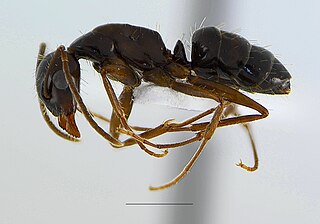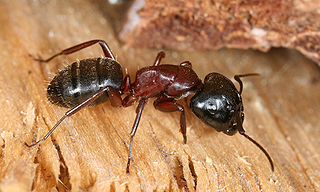
Honeypot ants, also called honey ants, are ants which have specialized workers that consume large amounts of food to the point that their abdomens swell enormously. Other ants then extract nourishment from them, through the process of trophallaxis. They function as living larders. Honeypot ants belong to any of several genera, including Myrmecocystus and Camponotus. They were first documented in 1881 by Henry C. McCook, and described further in 1908 by William Morton Wheeler.

Carpenter ants are large ants indigenous to many forested parts of the world.

The banded sugar ant, also known as the sugar ant, is a species of ant native to Australia. A member of the genus Camponotus in the subfamily Formicinae, it was described by German entomologist Wilhelm Ferdinand Erichson in 1842. Its common name refers to the ant's liking for sugar and sweet food, as well as the distinctive orange-brown band that wraps around its gaster.

The black carpenter ant is one of the largest and most common species of carpenter ant native to the central and eastern United States as well as eastern Canada.

Camponotus universitatis is a species of ant in the genus Camponotus, the carpenter ants. It is native to Eurasia, where it has been recorded in Spain, France, Italy, Switzerland, Albania, Bulgaria, and Turkey.

Camponotus nearcticus, commonly named smaller carpenter ant, is a relatively small carpenter ant. Its appearance is similar to Lasius niger, commonly named the black garden ant. The ant is a household pest.

Camponotus vagus is a species of large, black, Palaearctic carpenter ant with a wide range that includes much of Europe, a large area of Asia, and part of Africa.

Camponotus atriceps, previously referred as C. abdominalis, is a species of carpenter ant, endemic to the Americas.

Camponotini is a tribe containing 2 extinct ant genera and 8 extant ant genera, including Camponotus.

Camponotus japonicus, commonly known as the Japanese carpenter ant, is a species of ant native to eastern Asia. It is black, and one of the largest ants. A nest has about ten to thousands of individuals, and it can be a pest when it enters households or protects aphids. There are several subspecies of this ant in different areas of Asia, with the largest of the species being located in northern China.

Camponotus herculeanus is a species of ant in the genus Camponotus, the carpenter ants, occurring in Northern Eurasia, from Norway to Eastern Siberia, and North America. First described as Formica herculeana by Linnaeus in 1758, the species was moved to Camponotus by Mayr in 1861.

Camponotus floridanus, or Florida carpenter ant, is a species of ant in the genus Camponotus. First described as Formica floridana by Buckley in 1866, the species was moved to Camponotus by Mayr in 1886. The ant is widespread in Florida and occurs as far north as North Carolina and as far west as Mississippi.

The black-headed sugar ant, also known as the brown sugar ant, is a species of Formicinae ant endemic to Australia. Found throughout most states, the species is a member of the genus Camponotus, a cosmopolitan genus of ants commonly known as carpenter ants. It was formally described and named by British entomologist Frederick Smith in 1858. These ants are characterised by their black head, reddish-brown mesosoma and black gaster, which can change in colour.

Camponotus castaneus, the red hazelnut carpenter ant, is a species of carpenter ant located in the eastern United States. It is a primarily orangish-red ant in the family Camponotus. Its workers are usually around 8-10 mm, and queens around 18-20 mm. As with most Camponotus species, C. castaneus has majors and super-majors, usually appearing in the second or third year of the colony's founding, majors are usually 10-14 mm, with super majors being around 13-17 mm. C. castaneus has a generalist diet, feeding on insects and carbohydrates such as honeydew, which is easily accessible. The ant has a smooth thorax and abdomen, with 1 node separating them.

An ant garden is a mutualistic interaction between certain species of arboreal ants and various epiphytic plants. It is a structure made in the tree canopy by the ants that is filled with debris and other organic matter in which epiphytes grow. The ants benefit from this arrangement by having a stable framework on which to build their nest while the plants benefit by obtaining nutrients from the soil and from the moisture retained there.

Camponotus sericeiventris, the shimmering golden sugar ant, is a species of carpenter ant native to large parts of Central and South America.















